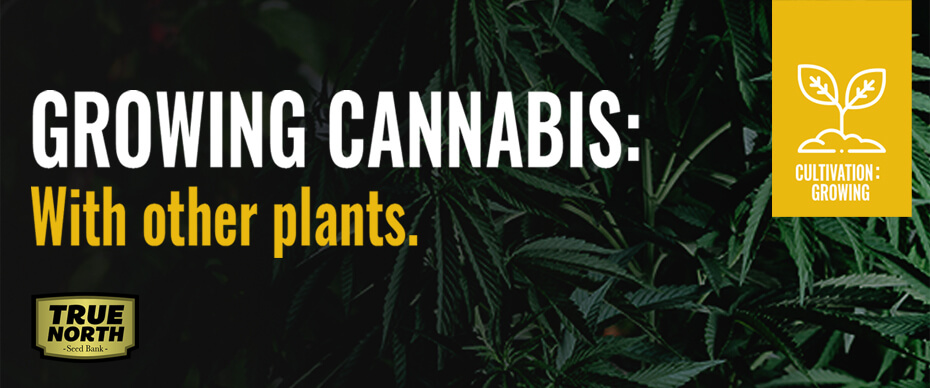
Companion planting is an age-old practice by which multiple crops are planted in proximity to promote healthy growth, increase production, and several more beneficial reasons.
Planting companion plants with your cannabis can be an easy solution to battle pests efficiently, help nutrient absorption, and stimulate other aspects to maximum yield. Different companion plants are recommended for indoor and outdoor cannabis grow operations to deal with various threats.
Let’s take a look below and see what it takes to secure and support your cannabis using natural methods.
Do plants Grow Better With Other Plants?
In most situations, provided you’re planting compatible plants, there’s a strong potential for each plant involved to grow better with other plants.
Since each garden is unique, several critical factors need to be considered before you plant your cannabis varietals with other types of plants.
Over the years, companion planting verifies that some combinations have real benefits unique to that specific plant pairing.
Gardners have known for ages that a diverse mix of plants makes for not only a healthy garden but a more beautiful garden with a plethora of plant diversity.
How companion plants help each other grow better begins with the basic idea of plants using the space efficiently while in tandem, attracting beneficial elements -- such as insects, nutrients, shade, etc.
Another primary advantage of companion plants is their ability to help minimize certain risks by increasing the yield even if one crop fails or is affected by natural hardship.
Beyond the obvious, planting cannabis with companion plants can also act as an ideal organic pest management technique.
With the right combinations, known as Trap Cropping, you can better prevent pest problems from attacking your primary crop by using the companion plant as a decoy.
What Are The Benefits Of Growing Cannabis With Other Plants?
Published in the peer-reviewed scientific journal Ecology Letters, it briefly describes how neighbouring plants communicate about specific attacks from harmful pests.
Plant roots are using certain mycelium fungi (mushroom) colony networks to communicate in most areas below the ground.
The surrounding plants use communications from mushroom root systems below ground to send early warning messages to nearby plants of attacking herbivores.
After the plants receive the message that their neighbouring plants are under attack, the plants receiving the messages can quickly activate their herbivore defence mechanisms.
Further research published in the journal BMC Ecology reveals how having good plant neighbours enhances the rate at which seeds germinate.
Benefits of growing cannabis with other plants include:
- Communication with neighbouring plants to warn of pests attacking
- Facilitate a safe environment to increase seed germination rate
- Certain plants are used as a pest decoy from the primary cannabis plants
- Reduce or eliminate the need to spray your plants with chemicals
- Facilitates nutrients in soil and absorption in plants
- Increases cannabis yield
Plants communicating with one another are critical biological survival mechanisms meant to keep the plants in the surrounding area alive, thriving, and safe from insect invasions.
For every outdoor cannabis cultivator, insects are among the absolute worst potential situations imaginable.
Certain species of insects have the potential to significantly damage or destroy your entire crop in a matter of a few hours.
One of the main reasons why companion planting is desirable for cannabis growing is its cheap, eco-friendly solution versus spraying your precious cannabis with different synthetic chemical insect repellents.
Some companion plants work by emitting a smell that annoys insects, while others attract animals that keep the insects away.
Other companion plants can provide your cannabis with much-needed nutrients by adding nitrogen to the soil, while others make nutrients readily available for absorption.
Another benefit every grower will appreciate is a companion plant's ability to increase its cannabis yield.
Plants such as chamomile can stimulate your cannabis plant to produce more oil resulting in denser buds.
Cover crops are a type of plant that typically grows near the ground, effectively minimizing nutrient loss in the soil by retaining moisture and nutrients, thereby lessening the need for water and fertilizers.
If cut to the ground level, they can also act as compost for the next round of plantation.
Furthermore, many companion plants have unique healing properties, while others can be used as food crops.
Cannabis companion planting is one of the most cost-effective ways to bring your cannabis garden to the next level.
What Grows Well With Cannabis?
With cannabis being such a unique and diverse plant, there are ample amounts of different plants that grow in harmony with the plant.
Plants that grow hand-in-hand with cannabis include:
- Camomile
- Alfalfa
- Basil
- Dill
- Lavender
One particular plant that grows wells with herb is camomile for its pleasant odour and gentle aroma that can attract insects that might otherwise harm the cannabis plants.
Camomile can also increase essential oil production by boosting the turgor of the neighbouring cannabis plant.
Fun fact: Turgor is the more rigid tissue in the plants, and if the turgor is low, the plant cells can lose too much water causing wilting flowers and leaves.
At the end of its life cycle, chamomile releases sulphur, potassium, and calcium back into the soil for future nutrient use.
Another popular plant that goes well with hemp is alfalfa.
What makes alfalfa attractive is its tall grass that grows quickly with deep roots in the ground, breaking up the soil and allowing greater water penetration and retention.
Also dubbed "the king of foods," alfalfa is specifically helpful while growing cannabis as it repels a pest that's particularly harmful to it called the lygus bug.
In addition, alfalfa also helps balance the level of nitrogen in the soil.
The next plant that grows well with hemp is basil.
Basil is a great companion plant for hemp due to its sweet scent, similar to camomile, and has a similar effect of boosting terpene production.
The aroma of basil also serves as a repellent to intruders like flies and mosquitoes.
Dill is another one of the most multipurpose companions for cannabis.
Dill is an excellent bodyguard for your cannabis plant due to its ability to repel spider mites, bugs, and aphids.
Considered a tasty plant by some insects, dill can help keep potentially harmful pests away from your cannabis.
Finally, lavender is great to grow with hemp because even though it smells lovely to humans, it has more of a disgusting odour to various pests such as mice and fleas.
How Do You Hide Outdoor Grow With Camouflage?
For outdoor growers who prefer to disguise their plants from their nosy neighbours and/or potential thieves, companion plants can provide you with a way that doesn’t need to compete with your cannabis plant.
Companion plants may not only look appealing, but they can also take the attention from a passing glance away from your cannabis plants.
A few basic options to camouflage your outdoor cannabis plants.
- Sunflowers
- Bamboo
- Honeysuckle
- Trees
- Lavender
- Basil
- Jasmin
- Mint
- Southernwood
Camouflaging your cannabis plants from sight is the first level of keeping them hidden and safe.
Once your cannabis plants begin to flower, you may need to mask the potent odours emanating freely.
To mask the pungent smells of your cannabis flowers, you may consider planting the companion plants of lavender, basil, jasmine, mint, and/or southernwood -- to name a few.
What Are Good Companion Plants For Outdoor Cannabis Growth?
While considering companion plants for outdoor growth, the main concern is their ability to resist pests and their ability to camouflage cannabis.
Suitable companions that effectively fight against pests include garlic, dill, basil, chamomile, basil, and marigold.
Sunflowers provide additional protection besides being pest repellent by camouflaging cannabis growth.
What Are Good Companions For Indoor Cannabis Growth?
When fully grown, cannabis plants tend to have a strong odour which might not be favourable for indoor planting.
Companion plants with sweet and masking odours come to the rescue in solving this problem.
Chamomile, basil, and lavender can give out indoor greenery pleasant odour.

About the author: Joe Powers
After an incident in the military, in 2011, Joe Powers began investigating cannabis by talking with industry leaders. In 2016, Joe launched Hemp Writer with its first publication in clarifying disinformation on specific updates to certain federal CBD laws.
Upon calling out a leading cannabis law firm spreading dis-info, Hemp Writer established itself as an authority in clarifying updated information emerging from the cannabis industry. Joe continues charging forwards with increasing momentum to continue fulfilling his vision of SHARING ACCURATE CANNABIS INFORMATION.










